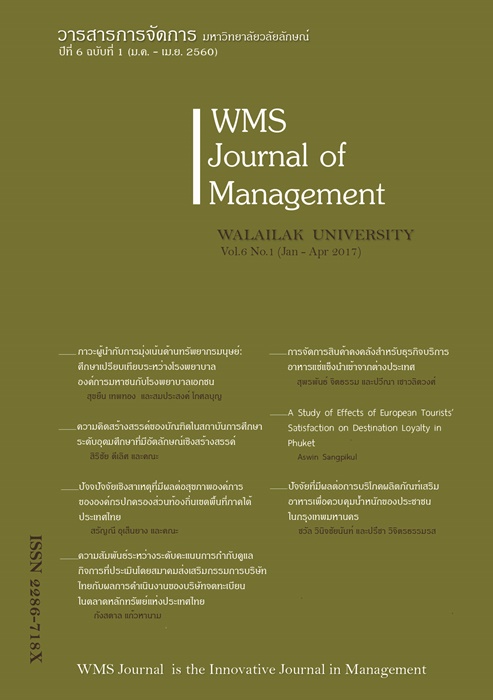Creative Thinking of Undergraduates in the Higher Education Institute with Creative Identity
Main Article Content
Abstract
The objective of this research were to study the Creative thinking level and the factor affecting to creative thinking of undergraduates in higher education institute with creative identity. The study was made using questionnaires given to 693 undergraduates of Silpakorn University. Data were analyzed by descriptive statistics, t-test, One Way ANOVA and Simple Correspondence Analysis
The result found that the most undergraduates in Bachelor of Arts, Applied Arts and Applied Science has average in Creative thinking. The factor affecting to creative thinking are mothers’ income, fathers’ occupation, curriculum, programs and faculties were significant at level of 0.05.Article Details
References
คณะกรรมการวิชาการคิดสร้างสรรค์เพื่อการจัดการคุณค่า. (2555). การคิดสร้างสรรค์เพื่อการจัดการคุณค่า. กรุงเทพฯ: สำนักพิมพ์มหาวิทยาลัยเกษตรศาสตร์
คอตเลอร์, ฟิลลิป และ คอตเลอร์, มิลตัน. (2556). 8 เส้นทางสู่ชัยชนะ การตลาดเพื่อสร้างการเติบโตทางธุรกิจ. แปลจาก Market Your Way To Growth. แปลโดย ณงลักษณ์ จารุวัฒน์. สมุทรปราการ: บริษัท ดับบลิวพีเอส (ประเทศไทย) จำกัด.
ชาตรี บัวคลี่. (2557). บทความวิชาการ: การประยุกต์ใช้แนวคิดของ Dr. Edward de Bono เพื่อการออกแบบสิ่งพิมพ์ที่สนใจ. วารสาร Veridian E-Journal, ปีที่ 7 ฉบับที่ 1 เดือนมกราคม - เมษายน 2557 ฉบับมนุษย์ศาสตร์ สังคมศาสตร์ และศิลปะ. สืบค้นเมื่อ 3 เมษายน 2558, สืบค้นจากhttp://www.ejournal.su.ac.th/upload/854.pdf
อรสา จูภัทรธนากุล. (2551). ความสัมพันธ์ระหว่างบุคลิกมิติสร้างสรรค์ พฤติกรรมการเผชิญปัญหา กับผลปฏิบัติงาน: กรณีศึกษาโรงพยาบาลสังกัดรัฐวิสาหกิจแห่งหนึ่ง. วิทยานิพนธ์หลักสูตรศิลปะศาสตร มหาบัณฑิต สาขาวิชาจิตวิทยาอุตสาหกรรมและองค์การ คณะศิลปะศาสตร์ มหาวิทยาลัยธรรมศาสตร์
Daskolia, M., Dimos, A., and Kampylis, P. G. (2012). Secondary Teachers' Conceptions of Creative Thinking within the Context of Environmental Education. International Journal of Environmental and Science Education, 7(2), 269-290.
De Bes, F. T., and Kotler, P. (2011). Winning at innovation: the A-to-F model. Palgrave Macmillan.
Gu, J., Zhang, Y., & Liu, H. (2014). Importance of social capital to student creativity within higher education in China. Thinking Skills and Creativity, 12, 14-25.
Horng, J. S., and Lee, Y. C. (2009). What environmental factors influence creative culinary studies?. International Journal of Contemporary Hospitality Management, 21(1), 100-117.
Wang, A. Y. (2007). Contexts of creative thinking: Teaching, learning, and creativity in Taiwan and the united states. Claremont Graduate University.
Wu, H. Y., Wu, H. S., Chen, I. S., and Chen, H. C. (2014). Exploring the critical influential factors of creativity for college students: A multiple criteria decision-making approach. Thinking Skills and Creativity, 11, 1-21.
Wu, H. Y., Chen, J. K., and Chen, I. S. (2010). Innovation capital indicator assessment of Taiwanese Universities: A hybrid fuzzy model application. Expert Systems with Applications, 37(2), 1635-1642.
Yamane, T. (1973). Statistics: An Introductory Analysis. New York: Harper and Row

